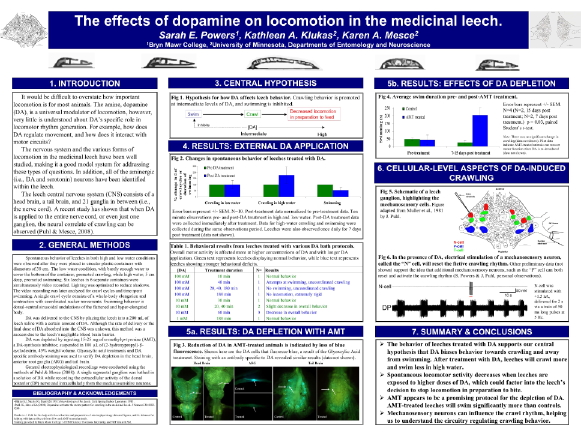|
Proposal
The effects of dopamine depletion
on searching, crawling and
biting behaviors
in the leech.
The cephalic (brain) projection neurons in leeches,
Hirudo medicinalis, influence behavioral decisions,
such as whether or not to swim or feed. These projection
neurons help in our understanding of decision-making
processes in other animals as well. Dopamine (DA) is
one of the important regulators in animal behavior,
and the DA system is dye coupled to the cephalic projection
neuron, Tr2, in leeches. Tr2 affects swimming behaviors;
its activation stops swimming. The motor rhythm for
swimming can be inhibited by DA, but DA does not inhibit
crawling. In this way, DA is related to swimming and
crawling behaviors. If DA affects some behaviors, it
would follow that it has an effect on others, such as
searching and feeding.
The purpose of my summer research will be to evaluate
if searching, biting, and crawling behaviors in intact
leeches are disrupted when DA is depleted. This is one
part of a two-part experiment to see if DA changes bite
duration, searching, and crawling behaviors. DA content
in the leech central nervous system will be selectively
depleted using the dopamine synthesis inhibitor a methyl-p-tyrosine
(AMT). Other methods of DA depletionóreserpine
and the neurotoxin 6-OHDAóhave been shown to
reduce serotonin (5-HT) in addition to DA, thus they
are less selective. High concentrations of AMT appear
to deplete octopamine (OA), but OA does not influence
biting in normal leeches; thus an intermediate concentration
will be used to target DA. With these facts in mind,
immunocytochemistry will be used to stain for the presence
of DA, OA, and 5-HT in collected cords of AMT treated
leeches. Additional detection methods HPLC and electrochemical
detection techniques will be used, if time permits,
to test for the presence or absence of DA, OA, and 5-HT
in collaboration with Dr. Robert Huber, at Bowling Green
State University.
To test biting and crawling behaviors (duration and
frequency), experimental and control leeches will be
observed for 15 minutes on a piece of Parafilm wax.
Frequency of search behaviors, head turns and lifts,
will also be analyzed. All tests will be video taped
for further analysis, and conducted blind. DA-depleted
leeches will be compared to control leeches, as well
as the DA-treated leeches from the other part of this
experiment.
Summary
The effects of dopamine on locomotion
in the medicinal leech.
It would be difficult to overstate how important locomotion
is for most animals. The amine, dopamine (DA), is a
universal modulator of locomotion, however, very little
is understood about DA’s specific role in locomotor
rhythm generation. For example, how does DA regulate
movement, and how does it interact with motor circuits?
The nervous system and the various forms of locomotion
in the medicinal leech have been well studied, making
it a good model system for addressing these types of
questions. In addition, all of the aminergic (i.e.,
DA and serotonin) neurons have been identified within
the leech. The leech central nervous system (CNS) consists
of a head brain, a tail brain, and 21 ganglia in between
(i.e., the nerve cord). A recent study has shown that
when DA is applied to the entire nerve cord, or even
just one ganglion, the neural correlate of crawling
can be observed (Puhl & Mesce, 2008).
Spontaneous behavior of leeches in both high and low
water conditions were observed after they were placed
in circular plastic containers with diameters of 30
cm. The low water condition, with barely enough water
to cover the bottom of the container, promoted crawling,
while high water, 5 cm deep, promoted swimming. Six
leeches in 6 separate containers were simultaneously
video recorded. The video recording was later analyzed
for crawl cycles and time spent swimming.
Two types of treatments were used for behavioral observation:
DA treatment, and DA depletion. DA was delivered to
the CNS by placing the leech into a DA bath. Although
the rate of delivery or the final dose of DA absorbed
into the CNS was unkown, this method was a success due
to the leech’s negligible blood brain barrier.
After treatment with DA there was not any change in
behavior in the low water condition, but in the high
water condition, crawling increased and swimming decreased.
This result is consistent with the hypothesis that intermediate
levels of DA activate crawling and suppress swimming.
The other treatment was with injections of 15-25 mg
of a-methyl-p-tyrosine (AMT), a DA-synthesis inhibitor.
AMT was shown to deplete DA throughout the leech with
antibody and glyoxcilic acid staining. 7-15 days post
AMT-treatment, leeches would swim significantly more
compared to pre-treatment observations (N=4, p=0.03
paired Student’s t-test).
The final aspect of this summer’s research consisted
of taking electrophysiological recordings from leech
ganglia. A single segmental ganglion was bathed in a
solution of DA while recording the extracellular activity
of the dorsal posterior (DP) nerve and intracellularly
from the mechanosensitive neurons. If fictive crawling
was observed from the DP nerve and one of the mechanosensitive
cells was stimulated, the crawl pattern would be reset.
In conclusion we found that the behavior of leeches
treated with DA supports our central hypothesis that
DA biases behavior towards crawling and away from swimming:
after treatment with DA, leeches will crawl more and
swim less in high water. When DA is depleted in leeches
by AMT they will swim significantly more than controls.
It was also shown that mechanosensory neurons can influence
the crawl rhythm, helping us to understand the circuitry
regulating crawling behavior.
Poster
(saved as a pdf)

|

